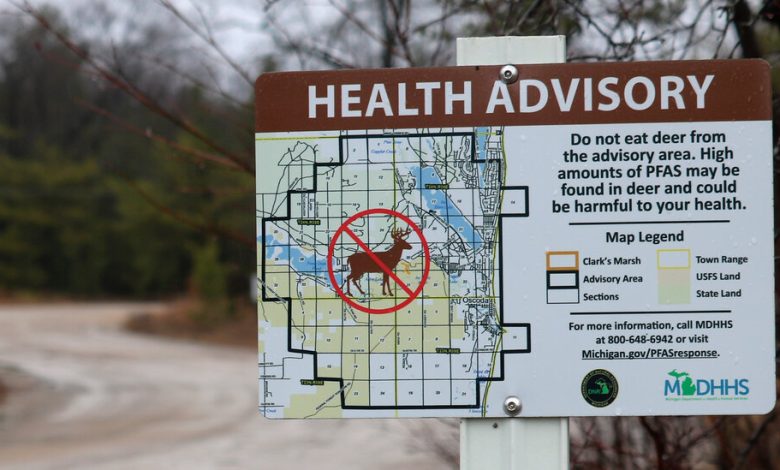How Widespread Are These Toxic Chemicals? They’re Everywhere.

Polar bears in the Arctic and plankton in the Pacific. Cardinals in Atlanta and crocodiles in South Africa.
While concern about PFAS compounds, also known as “forever chemicals” because they break down very slowly, has largely focused on people, the pollutants have also been detected in wildlife. Now, a review of research made public on Wednesday by the Environmental Working Group, a nonprofit advocacy organization that focuses on environmental safety, shows PFAS turning up in hundreds of wild animal species around the world.
In people, some of these chemicals are linked to cancers, developmental issues, reduced immune function, hormonal interference and heightened cholesterol. Last year, the Environmental Protection Agency found there was virtually no safe level in humans for two of the most widely used PFAS chemicals and proposed designating them as hazardous.
To get a sense of contamination in wildlife, researchers at the Environmental Working Group reviewed more than a hundred studies and created a map from their survey.
“We were like, ‘Holy smokes, this is shocking,’” said David Andrews, a senior scientist at the organization who worked on the review, recalling his team’s surprise at the sheer number and spread of studies documenting contamination.
Understand the Latest News on Climate Change
Driving inflation. Cotton farmers in Texas suffered record losses last year amid heat and drought. That crash has helped push the prices of tampons, cloth diapers, cotton balls and gauze bandages well above the overall U.S. inflation rate. It’s an example of how climate change is reshaping the cost of daily life in ways that consumers might not realize.
Thwaites ice shelf. Deploying an underwater robot beneath the rapidly melting ice shelf in Antarctica, scientists have uncovered new clues about how it is melting. The findings will help assess the threat it and other ice shelves pose for long-term sea-level rise.
World Bank president. David Malpass, under fire for months by critics who accused him of climate denialism, said that he will resign as the president of the World Bank by June, roughly a year before his term expires.
One Vanderbilt. The commanding new skyscraper in the heart of New York City, one of the world’s tallest buildings, was designed with climate change in mind. But it is already out of date.
Keeping the Keeling curve going. The eruption of Mauna Loa in Hawaii last year threw a six-decade-long survey of atmospheric carbon dioxide into crisis. It took a transoceanic scramble, and a dose of luck, for scientists to restart their measurements — on the next volcano over.
With many wild animal and plant species already staggering under a worsening biodiversity crisis driven by habitat loss, hunting and fishing, climate change and other pressures, scientists say they are increasingly worried about the added burden of PFAS contamination.
“These chemicals are likely serving as an additional stressor,” Dr. Andrews said.
Scientists are only beginning to understand that dynamic. One study found that concentrations of PFAS in endangered sea turtles correlated with reduced ability to hatch. Others have found levels in dolphins that compare to those in workers who have been occupationally exposed.
Most Americans have PFAS in their blood, according to the federal government. The chemicals are found in a variety of consumer products, including nonstick cookware, waterproof clothes and stain-resistant fabrics. They are being phased out in food packaging.
Formally called perfluoroalkyl and polyfluoroalkyl substances, the chemicals are created by fusing fluorine and carbon atoms to create a compound that doesn’t exist naturally. Because many of these chemicals break down very slowly, they tend to accumulate up the food chain.
Manufacturers counter that not all PFAS compounds are the same.
“It is not scientifically accurate or appropriate to group this vast family of solid, liquid and gaseous substances into a one-size-fits-all class,” saidTom Flanagin, a spokesman for the American Chemistry Council.
The Environmental Protection Agency says research is continuing to better understand the potential harm of all kinds of PFAS compounds.
Researchers working in the field already knew them to be widespread in wildlife.
“PFAS are everywhere and in most animals surveyed,” said Rainer Lohmann, a professor of oceanography at the University of Rhode Island who focuses on PFAS contamination and was not involved in the Environmental Working Group’s review. “But collecting that information and putting it together is a huge effort. And I am not sure the general public is fully aware how thoroughly these chemicals have penetrated the environment.”
Dr. Lohmann noted that areas on the map that seem to have less contamination — Africa, South America and much of Asia — probably just appear that way because of a lack of studies conducted in those places.
The map of global PFAS contamination would be even more dramatic and revealing, he said, if it included plants and algae.




